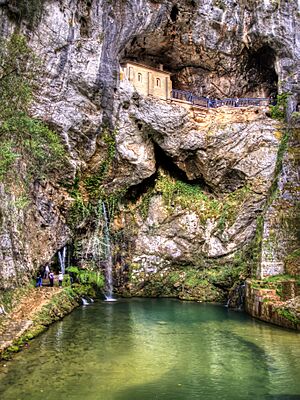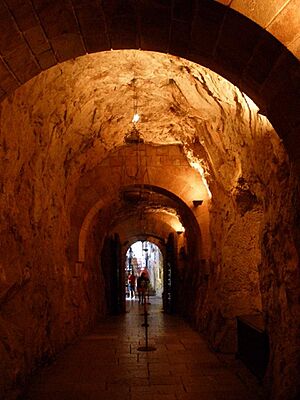Santa Cueva de Covadonga facts for kids
The Santa Cueva de Covadonga (which means Holy Cave of Covadonga) is a special religious place in northern Spain. It's a cave found in the amazing Picos de Europa mountains. This cave is part of a small area called Covadonga, located in the town of Cangas de Onís in Asturias.
This important place is dedicated to the Virgin Mary. It's famous because a very important battle happened here in the year 718. This battle was the start of the Spanish Reconquest, a long period when Christian kingdoms took back land in Spain.
Contents
What is the Holy Cave of Covadonga?
The Holy Cave is a natural cave that has been used as a place of worship for a very long time. Some people believe it was a sacred spot even before Christianity, perhaps for ancient nature worship. There was a fountain and the cave itself, which people saw as holy.
Christian stories say that a leader named Pelagius of Asturias was chasing a criminal who hid in the cave. There, Pelagius met a wise hermit (someone who lives alone for religious reasons) who was praying to the Virgin Mary. The hermit asked Pelagius to forgive the criminal, saying that Pelagius himself would one day need the cave's protection.
The Battle of Covadonga
Muslim historical writings tell us that Pelagius and his small army hid in this cave during the Battle of Covadonga. They survived by eating honey left by bees in the rock cracks.
Christian stories, however, say that the Virgin Mary helped them in a miraculous way. They believe her help was key to their victory, pushing back the attacks on the cave.
Building the Sanctuary
The first building inside the Holy Cave was a small chapel (a small church). It was built by King Alfonso I of Asturias to celebrate Pelagius's victory over the Muslims. This chapel was dedicated to the Virgin Mary, who became known as Our Lady of Covadonga or La Santina.
Besides the altar for the Virgin, there were also altars for Saint John the Baptist and Saint Andrew. King Alfonso gave this church to the Benedictine monks, who are a group of religious men.
The cave's original wooden structure was destroyed by a fire in 1777. The beautiful wooden statue of the Virgin Mary and baby Jesus that you see today was made in the 16th century. It was given to the sanctuary in 1778.
During the Spanish Civil War (a war in Spain from 1936-1939), the Virgin's statue disappeared. Luckily, it was found in the Spanish Embassy in France in 1939 and brought back. The current chapel, built in the Romanesque style, was designed by Luis Menéndez-Pidal y Alvarez.
Royal Burial Place
The shrine of Covadonga was very important for the early Christian kingdom of Asturias in the 8th century. Several members of the royal family were buried here in the Pantéon Real de Covadonga (which means English: Royal Pantheon or Royal Mausoleum).
These important people include:
- Pelagius of Asturias (died 737): He was the first king of Asturias.
- Queen Gaudiosa: Pelagius's wife.
- A sister of King Pelagius.
- Alfonso I of Asturias (693-757): The third king of Asturias.
- Queen Ermesinda: Alfonso I's wife, and Pelagius's daughter.
Pelagius first died in Cangas de Onís in 737 and was buried in the Church of Santa Eulalia of Abamia, where his wife was also buried. Later, King Alfonso X the Wise ordered their remains to be moved to the Holy Cave of Covadonga.
See also
 In Spanish: Santa Cueva de Covadonga para niños
In Spanish: Santa Cueva de Covadonga para niños
- Cueva de Achbinico
- Marian apparition
- Royal Collegiate church of San Fernando




